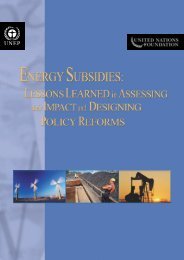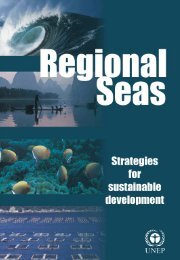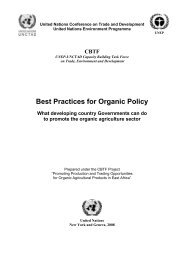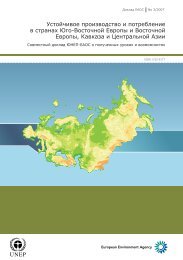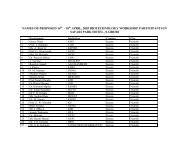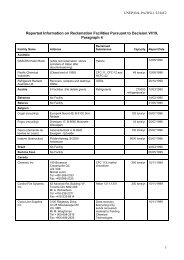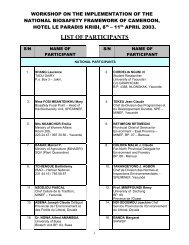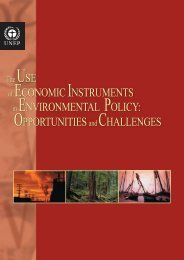Issues with energy-subsidy definitions - UNEP
Issues with energy-subsidy definitions - UNEP
Issues with energy-subsidy definitions - UNEP
You also want an ePaper? Increase the reach of your titles
YUMPU automatically turns print PDFs into web optimized ePapers that Google loves.
<strong>Issues</strong> <strong>with</strong> <strong>energy</strong>-<strong>subsidy</strong><br />
<strong>definitions</strong><br />
Ronald Steenblik<br />
Joint <strong>UNEP</strong> and Statistics Sweden<br />
Expert Meeting on Energy Subsidies<br />
Geneva, 26 May 2008
Subsidies<br />
Purpose of <strong>subsidy</strong> information<br />
• Transparency:<br />
• Keep governments honest<br />
• Know where and to whom money is going<br />
• Analysis:<br />
• Economic effects — international,<br />
macroeconomic, microeconomic<br />
• Distributional impacts — demographic,<br />
geographic<br />
• Environmental — geographic, industries
Information and tools<br />
Subsidies<br />
Transparency<br />
(Domestic & Intl.)<br />
Government budgets & accounts<br />
Notifications to EC and WTO<br />
Macro-economic<br />
analysis<br />
Micro-economic<br />
analysis<br />
Distributional<br />
impacts<br />
Environmental<br />
impacts<br />
National accounts (SNA)<br />
CGE models<br />
Sectoral accounts (e.g., PSEs)<br />
Partial equilibrium or CGE models<br />
National accounts<br />
Sectoral accounts (e.g., PSEs)<br />
Social Accounting Matrix (SAM)<br />
Sectoral accounts (e.g., PSEs)<br />
Environmental parameters or indicators<br />
Partial equilibrium or CGE models
Definitions of subsidies (1)<br />
Subsidies<br />
UN Statistical<br />
Office (SNA)<br />
Subsidies: “Current unrequited payments that<br />
government units … make to enterprises on the<br />
basis of the levels of their production activities or<br />
the quantities or values of the goods or services<br />
which they produce, sell or import.”<br />
WTO (SCM(<br />
SCM<br />
Agreement)<br />
WTO (GATS(<br />
GATS)<br />
Investment grant: “Capital transfers in cash or<br />
in kind made by governments to other resident<br />
or non-resident institutional units to finance all or<br />
part of the costs of their acquiring fixed assets.”<br />
Subsidy: “A A financial contribution by a<br />
government … [in which] a benefit is thereby<br />
conferred.” Distinction made between specific<br />
and non-specific (e.g., general infrastructure).<br />
Subsidy: Not yet defined! (But leans towards<br />
Article 1)
Subsidies<br />
WTO classification of subsidies<br />
Goods<br />
Specific<br />
infrastructure<br />
Fuel<br />
Transport<br />
General<br />
infrastructure<br />
?<br />
Services
Definitions of subsidies (2)<br />
Subsidies<br />
OECD<br />
(Agricultural<br />
Directorate)<br />
Producer Support Estimate: “an indicator<br />
of the annual monetary value of gross<br />
transfers from consumers and taxpayers to<br />
support … producers … arising from policy<br />
measures which support [the sector],<br />
regardless of their nature, objectives or<br />
impacts on … production or income.”<br />
Some transport,<br />
fisheries and<br />
environmental<br />
economists<br />
Subsidy: Varying <strong>definitions</strong>, some including,<br />
in addition to OECD-PSE or WTO-SCM<br />
agreement, value of all environmental<br />
externalities, others excess of total social<br />
cost over total revenues, or of marginal social<br />
cost over price.
Subsidies<br />
Definitions of environmentally harmful<br />
subsidies<br />
Constantly evolving and not “agreed”:<br />
• OECD 1998: “… all kinds of financial supports and<br />
regulations that are put in place to enhance the<br />
competitiveness of certain products, processes or regions,<br />
and that, together <strong>with</strong> the prevailing taxation regime,<br />
(unintentionally) discriminate against sound environmental<br />
practices.”<br />
• OECD 2003: “a a <strong>subsidy</strong> can be defined as ‘environ-<br />
mentally harmful’ if it encourages more environmental<br />
damage to take place than what would occur <strong>with</strong>out the<br />
<strong>subsidy</strong>.”<br />
• Others (e.g., Green Budget Germany): “those subsidies<br />
the phase-out of which would contribute to the<br />
improvement of the quality of the environment and the<br />
better management of natural resources.”
Subsidies<br />
Crucial point No. 1!<br />
Many subsidies are potentially environmentally<br />
harmful, but classification of a particular <strong>subsidy</strong><br />
as environmentally harmful is hazardous in the<br />
absence of analysis.
Subsidies<br />
Pros and cons of wide and narrow<br />
<strong>definitions</strong> of (<strong>energy</strong>) subsidies<br />
• Wideness (up to a point) is preferable,<br />
but more important is level of accessible<br />
detail.<br />
• One can have a fairly wide definition of a<br />
<strong>subsidy</strong> (or, less confusingly, “support”)<br />
even if data are not available — provided<br />
one is clear about what is missing. (See,<br />
e.g., SNA.)<br />
However …
Subsidies<br />
… including non-internalised<br />
(environmental) externalities is problematic<br />
I. Subsidies usually refer to consequence of government<br />
action, not inaction.<br />
II.<br />
III.<br />
IV.<br />
Externalities are important in their own right: combining<br />
them <strong>with</strong> subsidies can lead to double-counting<br />
(especially for EHS!) and confusion.<br />
Most subsidies can be quantified relatively easily;<br />
estimates of externalities are imprecise, potentially huge<br />
and often site-specific specific (except for GHGs). If un-<br />
internalized externalities must be included, then virtually<br />
every current <strong>subsidy</strong> estimate could be branded<br />
"incomplete", thereby undermining their credibility.<br />
Those who argue for their inclusion only ever seem to be<br />
concerned about externalities important to them. Yet<br />
externalities are ubiquitous, and include more than just<br />
those that impact on the environment.
Subsidies<br />
Crucial point No. 2!<br />
Not including externalities in the definition of a<br />
<strong>subsidy</strong> does not mean that they are thereby<br />
deemed unimportant or can be ignored.<br />
It is the role of the analyst to then use the<br />
<strong>subsidy</strong> and externality information to, for<br />
example, determine socially efficient prices.
Subsidies<br />
So, which approaches to defining and classifying<br />
subsidies are appropriate for environmental<br />
evaluation?<br />
• Compatibility <strong>with</strong> various needs and uses —<br />
e.g., aggregation of, or comparison among,<br />
different economic sectors — suggests that<br />
coverage of subsidies to <strong>energy</strong> be broad, but not<br />
extend to externalities.<br />
• Use multi-dimensional classification based on<br />
objective criteria (e.g., sub-sector, sector, production<br />
factor or input, geographic area).<br />
• Design to be able to correlate <strong>subsidy</strong> information<br />
<strong>with</strong> tax and revenue data …<br />
• … and environmental information.
Boundaries<br />
Subsidies<br />
• In deciding what is an <strong>energy</strong> <strong>subsidy</strong>, how far<br />
should one cast the net?<br />
• Clearly, support for the production of primary<br />
<strong>energy</strong> and transformation should be included.<br />
• But what about subsidies to <strong>energy</strong>-consuming<br />
goods (like cars, ships and aircraft), or<br />
associated infrastructure (roads, harbours and<br />
airports)?<br />
• Issue need not be resolved immediately, as<br />
long as accounts clearly identify what is being<br />
subsidized, so others can use only a sub-set set of<br />
the estimates, if they so choose.
In conclusion<br />
Subsidies<br />
• Ideally, people constructing sectoral (or<br />
satellite) <strong>subsidy</strong> accounts should use<br />
<strong>definitions</strong> that are consistent <strong>with</strong> general<br />
<strong>definitions</strong> already in use at international level.<br />
• SNA and WTO <strong>definitions</strong> are compatible <strong>with</strong><br />
each other, but it would be useful for somebody<br />
to do a detailed mapping to show how they<br />
relate to each other.<br />
• Sectoral accounts need to identify their<br />
boundaries clearly, in order to avoid double-<br />
counting<br />
• Externalities are important, but should be left<br />
out of the definition of “<strong>energy</strong> <strong>subsidy</strong>”.



